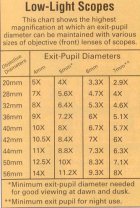...by the power? So a 50mm-objective-lens scope that's 10 power has an exit pupil of 5mm?
'My' NightForce has a 56mm OL and a power range of 12 to 42. So at 12-power the exit pupil is 4.7mm while at 42-power it's only 1.3mm?
How does this jibe with the 'Maximum' data of the prospective March 10-60X52 published here... http://www.6mmbr.com/bulletin.html ? The 0.86mm number for 'Minimum' appears correct as 52mm divided by 60, but the Max ought to be,52/10 =) 5.2mm and not 3.06mm. Is there some other restriction in the tube?
'My' NightForce has a 56mm OL and a power range of 12 to 42. So at 12-power the exit pupil is 4.7mm while at 42-power it's only 1.3mm?
How does this jibe with the 'Maximum' data of the prospective March 10-60X52 published here... http://www.6mmbr.com/bulletin.html ? The 0.86mm number for 'Minimum' appears correct as 52mm divided by 60, but the Max ought to be,52/10 =) 5.2mm and not 3.06mm. Is there some other restriction in the tube?











